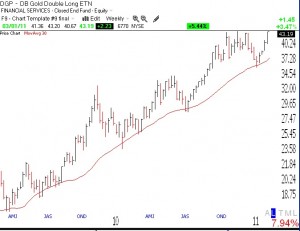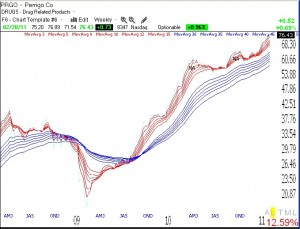The market averages are very volatile and have come back down to critical support again. The new QQQQ short term up-trend is in jeopardy. I am raising cash in my trading account and am slowly wading into the ultra bearish QQQQ ETF, SQQQ. SQQQ is designed to go up 3x as much as the QQQQ (Nasdaq 100) declines. I enter the inverse ETF’s when the market indexes weaken. If a true down-trend develops, I will add to my position in SQQQ. SQQQ rose 4.7% on Tuesday, as the QQQQ declined -1.6%. By buying the inverse ETF’s, one’s account can grow as the market declines. It is very important to be cautious as I wait for the market to reveal its short term trend. The longer term trend remains up, for now.
I also own the ultra long gold ETF, DGP. DGP strives to rise 2X as much as gold does. DGP rose +3.4% on Tuesday as GLD rose +1.7%. Note that DGP (and GLD) is in a picture perfect Weinstein Stage 2 advance and has found support at the 30 week average (red line) repeatedly during the past 2 years. Click on weekly chart to enlarge.

